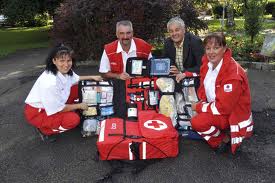Ideas and Free Throws
Assume, for a moment, that I’m your manager. I call you into my office one day and say, “You’re doing pretty good work … but you’re going to have to get better at shooting free throws on the basketball court. If you want a promotion this year, you’ll need to make at least 75% of your free throws.”
What would you do? Assuming that you don’t resign on the spot, you would probably get a basketball, go to the free throw line, and start practicing free throws (also known as foul shots). Like most skills, you would probably find that your accuracy improves with practice. You might also hire a coach or watch some training videos, but the bottom line is practice, practice, practice.
Now, let’s change the scenario. I call you into my office and say, “You’re doing pretty good work … but you’re going to have to get better at creating ideas. If you want a promotion this year, you’ll need to increased the number of good ideas you generate by at least 75%.”
Now what? Well … I’d suggest that you start practicing the art of creating good ideas. In fact, I’d suggest that it’s not very different from practicing the art of shooting free throws.
But shooting free throws and creating ideas seem to be very different processes. Here’s how they feel:
- Shooting free throws – you get a basketball, you walk to the line – 15 feet from the basket – and you launch the ball into the air. You’re conscious of every action. You recognize that you’re the cause and a flying basketball is the result.
- Creating ideas – nothing happens … then, while you’re walking down the street, minding your own business – poof! – a good idea pops into mind. You have no sense of agency. Instead of feeling like the cause, you feel like the effect.
The two activities seem very different but, actually, they’re not. In both cases, you’re doing the work. With free throws, you readily recognize what you’re doing. With ideas, you don’t. Free throws happen in your conscious mind, also known as System 2. New ideas, on the other hand, happen below the level of consciousness, in System 1. When System 1 works up an idea, it pops it into System 2 and you become aware of it.
We understand how to practice something in System 2 – we’re aware of our activity. But how do we practice in System 1? How can we practice something that we’re not aware of?
We think of our mind as controlling our body. But, as Amy Cuddy has pointed out, our bodily activities also influence our mental states. If we make ourselves big, we grow more confident. If we smile, our mood brightens.
So how do we use our bodies to teach our brains to have good ideas? First, we need to observe ourselves. What were you doing the last time you had a good idea? I’ve noticed that most of my good ideas pop into my head when I’m out for a walk. When I’m stuck on a difficult problem, I recognize that I need a good idea. I quit what I’m doing and go for a walk. Oftentimes, it works – my System 1 generates an idea and pops it into System 2.
In my critical thinking classes, I ask my students to raise their hands if they have ever in their lives had a good idea. All hands go up. Everybody has the ability to create good ideas. The question is practice.
Then I ask my students what they were doing the last time they had a good idea. The list includes: out for a walk, driving, riding in a car, bus, or train (but not an airplane), taking a shower, drifting off to sleep, and bicycling.
I also ask them what activities don’t generate good ideas. The list includes: when they’re stressed, highly focused, multitasking, overly tired, overly busy, or sitting in meetings.
So how do we practice the art of having good ideas? By doing more of those activities that generate good ideas (and fewer of those that don’t). The most productive activities – like walking – seem to occupy part of our attention while leaving much of our brainpower free to wander somewhat aimlessly. Our bodily activity influences and stimulates our System 1. The result is often a good idea.
Is that perfectly clear? Good. I’m going for a walk.
Innovation: Idea First Responders
Companies spend a lot of time encouraging their employees to create and propose new ideas. We have training sessions, brainstorming sessions, retreats, team building exercises, ropes courses — you name it and we’ve tried it. So what happens when an employee actually proposes an idea? All too often, we kill the idea before it has a chance to breathe. We don’t do it on purpose. We do it because we’re not properly trained as Idea First Responders™.
An employee proposing a new idea is in a fragile situation. While she may believe it’s a great idea, she’s also unsure how others will respond. Will they like it? Will they support the idea? Or will they dismiss it with a roll of the eyes and a “that’ll never work here” comment. All too often, we suppress ideas without realizing it. If we suppress our employees’ first idea, it’s unlikely that they’ll come back with a second one. Why bother?
In the world of accidents and emergencies, first responders have two critical roles: stabilize and transport. The same thinking can apply to ideas. When an employee proposes an idea, we need to stabilize it and transport it to the next stage of the idea development process.
Stabilizing an idea involves several steps. The Idea First Responder (IFR) may need to flesh out the idea and help the proposer think through its various ramifications. Additionally, the proposer may have lots of questions, including some “dumb” questions. The IFR needs to answer these respectfully. Even a small amount of sarcasm can stifle the entire process. Stabilizing also means encouraging the process. The IFR needs to encourage the proposer to continue to propose new ideas, even if this one doesn’t work out.
The second stage is to transport the idea to the innovation process. This may involve asking the proposer to do more work before moving forward. When the work is completed (assuming it’s satisfactory), the Idea First Responder helps transport it into a more formal process. This may be a weekly staff meeting or it may be a more formal Innovation Committee. During the transport process, the IFR has several critical issues to tend to:
- Who champions the idea? Some proposers will want to present the idea themselves. Others will feel uncomfortable presenting an idea in a formal environment — especially if it involves senior executives. The IFR needs to sort this out. If another person is selected to champion the idea, the IFR needs to ensure that the proposer gets credit for originating the idea.
- Communicating progress. It takes time to develop an idea. The IFR needs to keep the proposer informed. Letting an idea disappear into a black hole only discourages the idea generation process.
- Breaking the good or bad news. If it’s good news, the IFR should ensure that the proposer gets formal, public recognition. If it’s bad news, the IFR needs to let the proposer know why the idea didn’t succeed and continue to encourage the process. “Well, this one didn’t work out, but senior staff really appreciates what you did and hopes you’ll think up more ideas in the future.” A nice note from the CEO can help a lot here.

